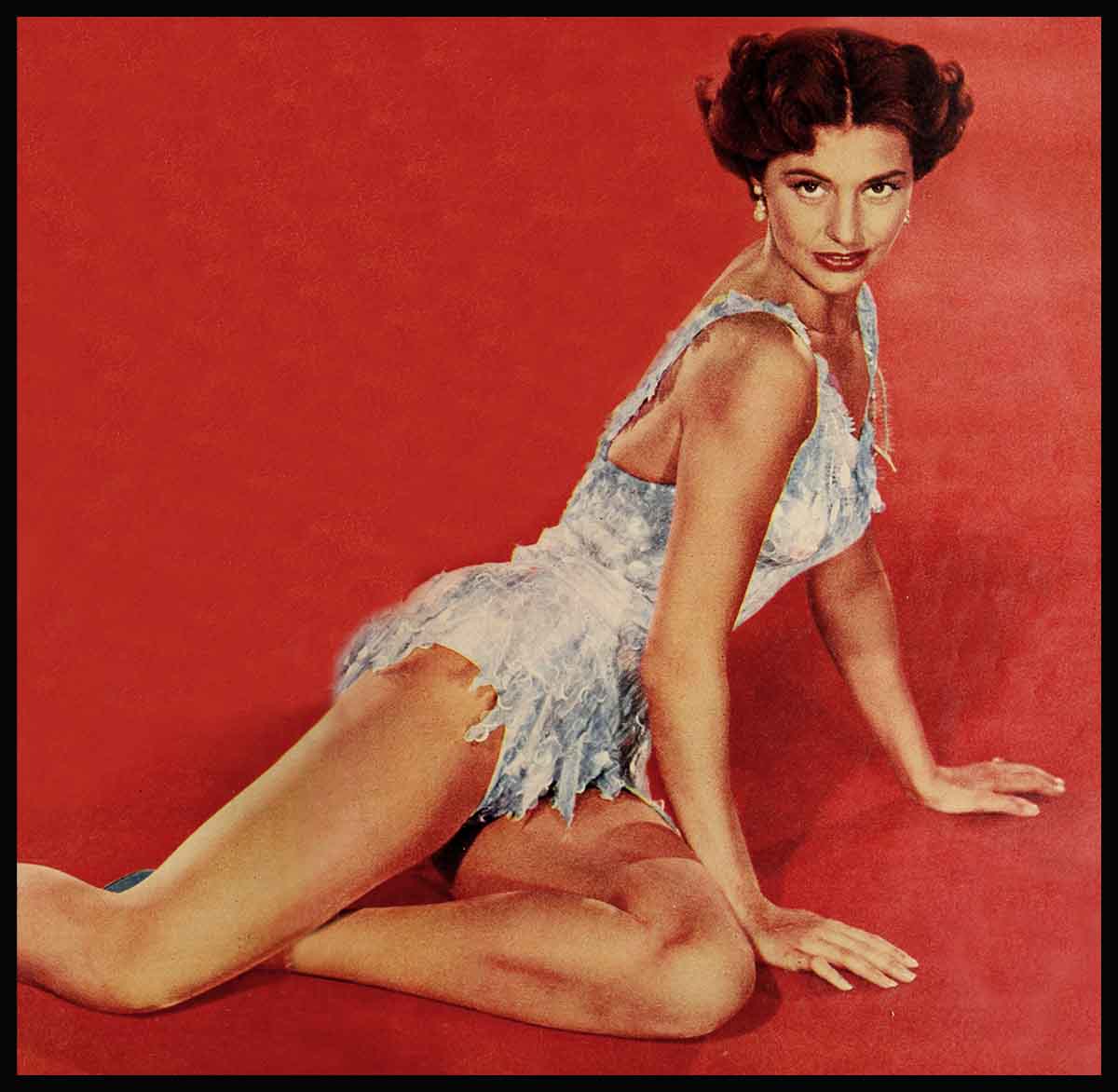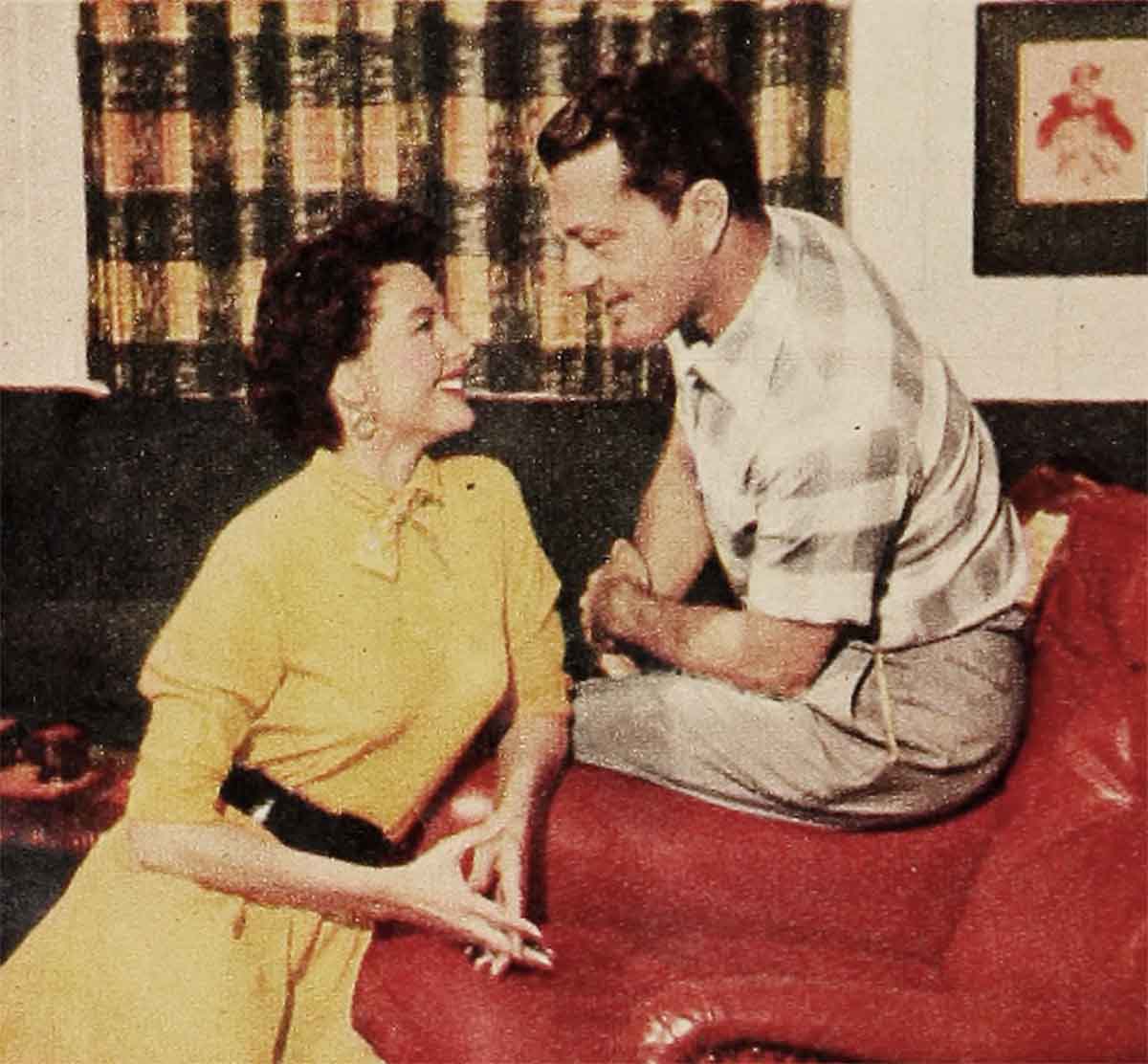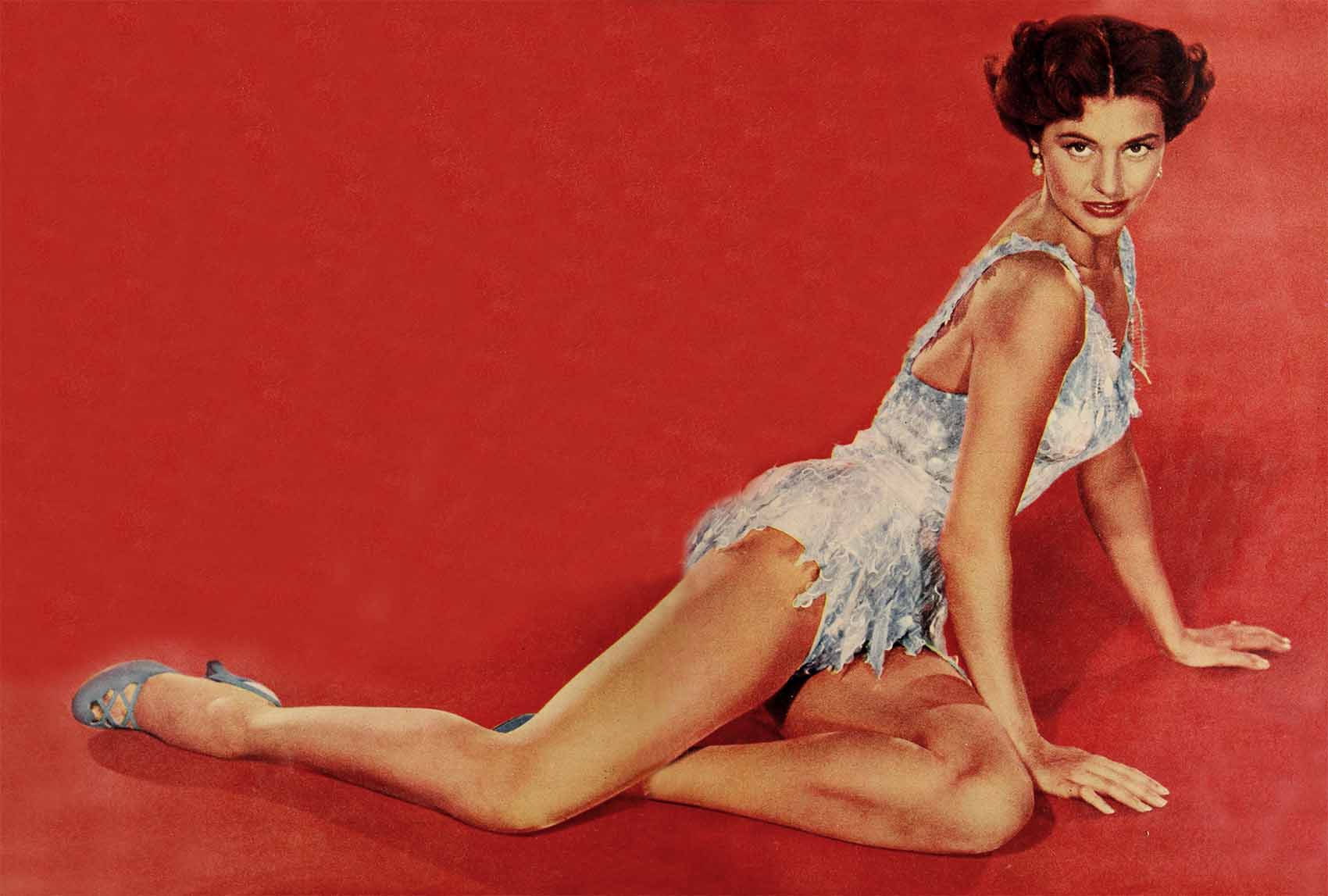
Once A Tomboy!—Cyd Charisse
When Cyd Charisse blew into the movies in 1944 people asked “What is Cyd Charisse?” It sounded more like a dessert than; a name, and Cyd lives up to the analogy. Tall and willowy, she is topped off by a swirl of dark hair that suggests the color of smoke. Her brown eyes are wide set and tilting at the corners, and her teeth are perfectly rounded white gems that flash in a disarming smile. The combination adds up to a dish that anyone would consider luscious, and a bit beyond reach, too. Cyd looks expensive and her manner on first meeting seems aloof, almost haughty.
If this is true, it is possibly because she is expecting the usual opening gambit—an inquiry about her name. Cyd figures that in all her life she has met perhaps a dozen people who have not immediately inquired as to the nature of and the reason for her appellation. The answer is quite simple. The “Cyd” comes from her older brother’s abortive attempt to say “sister,” and the Charisse part of it comes from her first husband, dancing instructor Nico Charisse.
She is one of the few to enter Hollywood’s golden circle of contract signers without undergoing a change of title. Cyd Charisse, thought MGM, was as high flying, as fancy and as distinctive as a name could get, and even their experts couldn’t dream up anything better.
Few people know it, but Cyd’s original monicker was even more breathtaking. She was born Tula Ellice Finklea, in Amarillo, Texas. The Tula stemmed from an aunt, the Ellice was borrowed from an uncle, and the Finklea is of Welsh derivation. The fact she began life in Texas astounds most people because Cyd’s exotic appearance plus her interesting name give the impression that she has floated to these parts on an alabaster slab, cushioned with carpets from Baghdad and fanned by Nubian slaves. Amarillo comes as somewhat of a shock.
As a matter of fact, wherever Cyd goes she is taken for a native. Her bloodline includes not only Welsh, but French, English, Scotch, and a bit of American Indian. When she is in Paris they remark that she looks so French, when in England she is taken for an upper class Limey, in Italy they accept her as another Latin, and although to date Cyd hasn’t set foot on an Indian reservation, she knows what to expect in the way of comment on her first visit.
If she looks expensive, it comes naturally. Her father was a jeweler, and one of Cyd’s favorite playthings as a child was the scale on which the diamonds were weighed. The scale was allowed but the diamonds were not, and happily enough the hands-off policy where gems were concerned left Cyd with no frustrations. She can take or leave valuable jewels, and is just as content with a costume bauble as she would be with a diamond that would have fractured her father’s scale.

Here is where the illusion of Cyd’s aura of splendor begins to fall apart. It takes a while to probe it, for she has a natural reserve that doesn’t lend itself to easy conversation concerning herself, but when her personality begins to come out in the wash of an interview it is even more surprising than the bit about Amarillo. Cyd Charisse, by all counts, should mother little girls and put them in dresses drowning in ruffles. She should sit in a beautifully appointed drawing room and look more like a formal portrait than a human being. But she does not. Cyd has two sons, both of whom are long gone on the happy fact that they are boys, and they do little to quash the evidence. The house is normally quaking with noise and activity, and more often than not Cyd is contributing herself. Nicky, now ten, is teaching her how to blast the seams out of a punching bag, and from all reports she has done the impossible, having garnered grudging respect from her elder son for her athletic ability. Nicky is not old enough to realize or to grasp the unbelievable fact that his graceful mother, who seems always to float through the house, was once one of Amarillo’s best-known tomboys.
“It was unavoidable,” says Cyd. “I had an older brother.” His name was Earnest E., the namesake of his father, and to avoid confusion the family referred to him as “E. E.”, which Cyd admits sounds like a captured mouse. E. E. was a year older than his kid sister, and in the absence of a brother he latched on to Cyd and taught her how to kick footballs, scale fences, knock a Texas Leaguer and, most of all, to climb trees. The two kids built a tree house all their own and disappeared into its heights so often and so long that their mother was frantic and their father reread The Theory of Evolution by Darwin.
The art of handling a punching bag requires two attributes—timing and muscles—and Cyd has both. They are two of the reasons why she has enjoyed spectacular success as a dancer. The other is that she loves to dance. Last winter she achieved one of the goals of all ballerinas: she danced in a picture with Fred Astaire. There is little use trying to explode the myth about Mr. Astaire and the thousands of his would-be dancing partners. If there is such a thing as magic feet, Fred has them. Asked about her reaction to dancing with him, Cyd sighed, “Of course I wanted to dance with him! Every dancer wants to. I can’t imagine anyone saying no to such an opportunity. The man is fabulous. Nobody can walk like him, no one has his endurance. He can pick up a cane and ad lib a dance that is breathtaking. I don’t believe there’ll ever be another Fred Astaire!”
The tribute came from her two days after she had finished work with him in The Bandwagon, a time that gave an acid test to reactions, for it is well known that Mr. Astaire is a perfectionist and works so hard that others working with him automatically strive for the same results. Other dancers have been known to retire with curled toes and refuse to take a step for months afterward, but Cyd came out of it still filled with awe and respect.
Her dancing career was begun, unwittingly, by a doctor who recommended lessons as exercise. As a child Cyd was too thin, and Amarillo’s rugged winters kept its children indoors for a good part of the year. So she began to study with a local teacher who had been a pupil of the famous Theodore Kosloff. She was eight years old then, and by the time she was 13 her parents decided to send her to live with friends in California where she could further her studies. It ended for Cyd the life she had always known, the summer vacations in New Mexico or Colorado, the pillow fights and daydreaming hours with her brother, the close association she had enjoyed with her father. But it was what she wanted, for she was happiest when she was dancing and her parents, particularly her father, loved dancing.

For two years she studied in California, attending the school of Nico Charisse, and when she was 15 she auditioned for Colonel de Basil of the Ballet Russe. Her father was immediately telephoned back in Texas and asked that his daughter be permitted to join the troupe. Mr. and Mrs. Finklea were not the kind of parents to stand in the way of a talented child, and despite Cyd’s youth they let her go. Her father worried about it considerably but her mother was so calm that to this day Cyd laughs about it. “She seemed so trusting that everything would be all right—didn’t so much as turn a hair. Maybe it’s because I was tall for my age and had always seemed older, but at any rate if she was worried I never knew it. But her grandchildren—they’re different! The boys can’t stumble over a doorstep that Mother doesn’t have hysterics.”
For a year she toured the United States with the ballet, during which time her father saw her debut as a soloist. It was providential that he did—he was so proud of her—for it was not much later, at a time when Cyd was en route to Europe with the troupe, that Mr. Finklea died. Cyd returned to be with the family for a while, then re-signed and went to Europe. There was no time to be a tourist; it was a matter of work and more work, and it went on until she was 16. At that time a vacation was announced for the company and Nico Charisse went to Europe to see her. Not many weeks later, in 1941, he and Cyd were married.
This time Cyd’s mother was considerably roused—‘“A little upset,’ says Cyd and smiles softly. “She wrote that she thought it best if I came home.”
The newlyweds returned to California at the outbreak of the war and their son Nicky was born in 1942. Soon after his birth Cyd was introduced to Gregory Ratoff, and the meeting resulted in her dance specialty in the director’s picture, Something To Shout About. There was another brief bit of dancing in Mission To Moscow,and then in 1945 she waltzed into a solid Hollywood career with her portrayal of the ballerina in Ziegfeld Follies. In that picture she was introduced in her role by Fred Astaire, and although Cyd was already an established star of the dance world, she was only 20 and at the beginning of her movie career, and it is doubtful if she even dreamed then that one day she would star opposite Astaire.
She was featured but not starred in four films the following year, and the year after that, 1947, saw her divorce from Nico Charisse, who just recently has remarried. Following the divorce Cyd lived quietly with her mother and son, and her career followed the same quiet level. MGM put her in two more pictures, neither of them giving her much opportunity to display herself as anything but a dancer. This suited Cyd because dancing was closest to her heart, but it did little to further her career, as audiences saw her purely as a terpsichorean and had no opportunity to catch her personality.
In 1948 her luck and her life began to change. At a party given by her agent Nat Goldstone she met Tony Martin, another of Goldstone’s clients. Accustomed to meeting tall, dark and handsome men who were also celebrities, Cyd was not particularly impressed and later refused his first invitation to dinner. When she finally did go out with him he took her to a Hollywood nightclub and proceeded to table hop all during the evening. She was even less impressed until she reminded herself, in all fairness, that Tony was only just released from the Army and so deliriously happy to be home again that he couldn’t resist saying hello to all his friends.
They were married in May of that year, and if Cyd had been bewildered by Tony Martin as a table-hopping date, she was even more nonplussed by the discovery that she had a country-hopping husband. In his profession as a singer Tony is constantly traveling to theaters in New York, and nightclubs in Miami, and their marriage, the first year in particular, was a series of forced separations. It has got to the point where Cyd is happiest when Tony is busy at a studio from 8 A.M. until 6 P.M., for although he may not be at home, he is at least in the same city. This is assuming, of course, that Tony makes ye picture in Hollywood. His last film, Easy To Love with Esther Williams, took him off to Florida for two months, and Cyd worked overtime to finish her role in The Bandwagon so that she could go with him. Cyd herself is sometimes guilty, such as the month spent in Mexico for the filming of Sombrero. Tony went with her for that one, but within a week had to leave for a singing engagement elsewhere. That was about the time that, out of a period of three months, they were together only two weeks. By now the divergent demands of their respective careers have become a family gag, and it is always remarked upon in high glee when they manage to have dinner together.
Considering the erratic circumstances their marriage has worked out extremely well. And they prove the point that opposites attract, for while Cyd is reserved and not overly fond of crowds, Tony is an extrovert who loves people—all kinds of people. Their friends include youngsters and oldsters, show people and non-professionals. When Cyd is working in a movie she prefers entertaining at home, and their house is seldom without guests, some staying for a sandwich, some for a two-week visit. It is a house that lends itself well to entertaining—big and rambling, with four fireplaces and a swimming pool, and surrounded by stretches of green lawn.
It is a paradise for Cyd, not only because it shelters her family, which now includes Nicky Charisse and three-year-old Tony Martin, Jr., but because she is basically a home-loving person. Despite this she goes along with Perpetual Motion Martin, who cannot sit still for more than two minutes. He may come home dead tired from a series of one-night stands, but after two or three days she notices the symptoms. He sits at the breakfast table sipping his coffee and reading the morning newspaper, but he can’t seem to concentrate. He keeps putting the paper down and staring out the windows. Finally he gets to the point. “Honey, let’s go somewhere.”
And Cyd smiles, “All right. Where?”
“Anywhere!” whoops Tony. “Come on, let’s pack!”
As she understands his penchant for activity, so he understands her love of dancing. He is in perfect accord with her career, knowing it makes her happy, and together they have ironed out the wrinkles caused by the combination of their interests.
The Martins love to sleep late and the boys, whose rooms are at another end of the house, cooperate like gentlemen until they hear the first indications that their parents are up and around. Bedlam follows. Tony Jr. pleads for a trip to the playground, Nicky drags Cyd to the punching bag and Tony calls up Leo Durocher to come over for lunch. There follows an hour of discussion, naturally about baseball, and Cyd sits in the midst of the males, doing her darndest to keep up with the finer points of the game. Her tomboy childhood helps her share Tony’s enthusiasm for all sports, but while she seemingly thrives in the world of men, she has a secret yearning for a daughter. “I like children and want more, but I’d have another immediately if I could be sure it would be a girl.”
It comes out, after all, that while Cyd might seem content in her rough and ready household, she would like to have just one other female around—a little character she could dress in ruffles. Men are fine up to a point, but a girl needs companionship. Tony, for instance, Cyd’s craze for shoes. She keeps them, dozens of them, in a specially built case, and while he only murmurs at the purchase of a new pair of street shoes, he goes into a snit when she brings home what she likes to call “a crazy pair.” Shoes are her Waterloo, and the more distinctive the better. Once, when ankle straps were the new rage, she brought home a pair of strapped sandals and the next morning found them in the garden, well chewed by the French poodle.
Shortly after their rescue, Tony was confronted by an irate wife, a soggy sandal in each hand.
“Well?” said Cyd.
He assumed a puzzled expression. “Well?” he said.
“You might not like them,” said Cyd, “but did you have to go to such lengths?”
“I don’t know what you’re talking about,” he said, but when he came home that evening he brought her flowers.
There is music in their house every waking hour, running the gamut from popular to classical, and if Tony isn’t humming a tune, Cyd is working to the rhythm on her practice bars. Tony Jr. has absolutely no interest in dancing and Nicky’s surrender has come only recently, with the advent of ballroom dancing shared by students of his school with the girls of Westlake School. Nevertheless, they both prefer hearing Pop sing to watching Mom dance.
They may not appreciate her talent, but some day they will, for Cyd’s lithesome grace and twinkling toes are well on their way to becoming world famous. Her torrid hilltop dance as a Mexican girl in Sombrero is callmg for air-conditioning of theaters, and her spectacular dances in The Bandwagon have at last convinced her MGM bosses that Cyd is worthy of a big star buildup. Accordingly, they plan starring her in their production of Kismet and are currently considering her for the lead when they make the screen version of Brigadoon.
Right now Cyd Charisse is known as the 11th dancing partner of Fred Astaire in pictures, but it is within the realm of possibility that some day male dancers will be hankering for a chance to play consort to Cyd Charisse, Queen of the Dance.
THE END
—BY JANE WILKIE
It is a quote. MODERN SCREEN MAGAZINE JULY 1953




